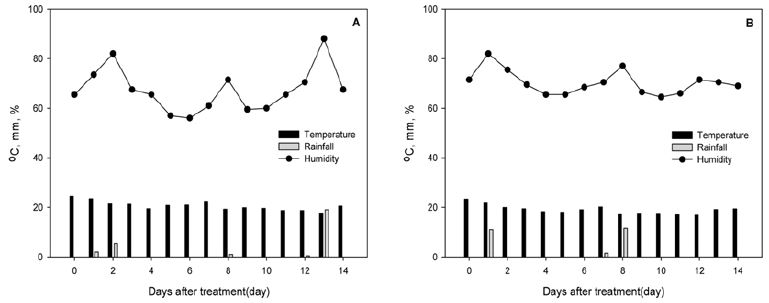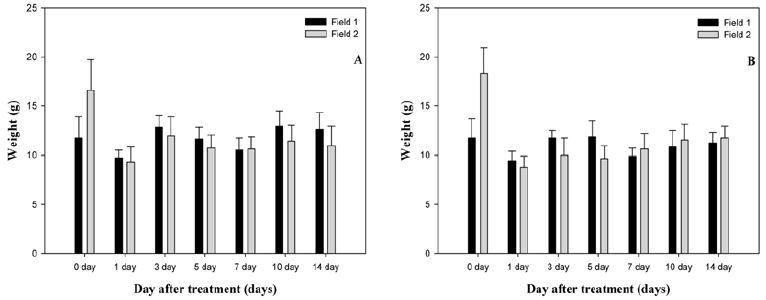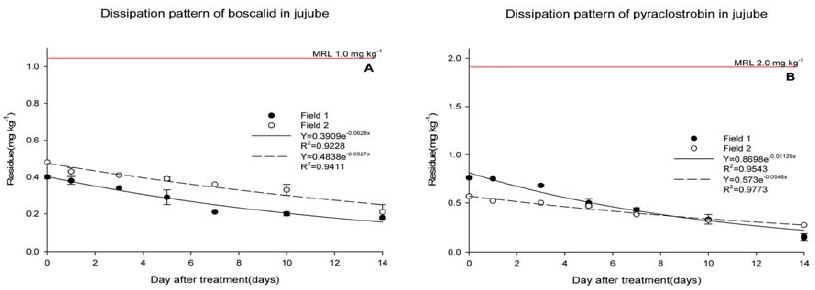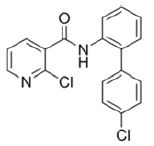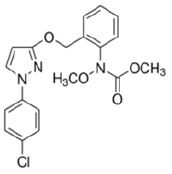
대추 중 살균제 boscalid와 pyraclostrobin의 잔류 소실 특성
초록
대추 중 boscalid와 pyraclostrobin의 잔류량을 조사하여 약제별 잔류소실과 생물학적 반감기를 산출하였다. 노지재배 중인 대추에 안전사용기준 농도로 희석한 boscalid와 pyraclostrobin을 다른 두 지역의 포장에서 각각 살포 후 0 (2시간), 1, 3, 5, 7, 10, 14일에 시료를 채취하여 HPLC/DAD로 분석하였다. 두 시험농약의 방법정량한계는 0.02 mg kg−1이었으며 시험분석법의 회수율 결과, boscalid는 101.8~109.3%, pyraclostrobin은 104.2~115.4%이었다. 저장안정성시험 결과, boscalid는 101.9~106.5%, pyraclostrobin은 104.6~110.6%이었으며 회수율시험 및 저장안정성시험 결과 CV값이 5% 미만이었다. 대추 중 boscalid의 초기 잔류량은 포장 1에서 0.40 mg kg−1이고 포장 2에서 0.48 mg kg−1이었으며, pyraclostrobin의 초기 잔류량은 포장 1에서 0.76 mg kg−1이고 포장 2에서 0.57 mg kg−1이었다. 대추 중 boscalid의 생물학적 반감기는 포장 1에서 11.0일, 포장 2에서 13.2일 이었으며, pyraclostrobin의 생물학적 반감기는 포장 1에서 6.1일, 포장 2에서 12.7일이었다.
Abstract
Dissipation pattern and biological half-lives of fungicides boscalid and pyraclostrobin were calculated on jujube. The pesticides were sprayed on jujube in two different field at the standard rate, respectively. The raw agricultural commodities were harvested at 0 (2 hr), 1, 3, 5, 7, 10 and 14 days after treatment, and analyzed by HPLC/DAD. The method limit of quantification (MLOQ) was 0.02 mg kg−1 for boscalid and pyraclostrobin. The recovery ranged 101.8~109.3% with below 5% of CV (Coefficient of variation) for boscalid and 104.2~115.4% with below 5% of CV for pyraclostrobin. An average initial deposit at field 1 and field 2 samples were observed 0.40 and 0.48 mg kg−1 for boscalid and, 0.76 and 0.57 mg kg−1 for pyraclostrobin, respectively. The biological half-lives of field 1 and field 2 were 11.0 and 13.2 day for boscalid, and 6.1 and 12.7 days for pyraclostrobin.
Keywords:
biological half-life, boscalid, jujube, pyraclostrobin키워드:
boscalid, pyraclostrobin, 대추, 생물학적 반감기서 론
농약은 현대사회농업에서 없어서는 안되는 필수 농자재이며, 농산물 재배 시 병, 해충, 잡초 등으로부터 작물의 손실 및 피해를 줄이고 나아가 농산물의 수확량을 증대시키는데 중요한 역할을 한다. 그러나 대부분 농약은 화학물질로 이루어져 있으며, 독성 및 작물에 잔존하는 농약잔류에 대한 안전성 등으로 인해 농약의 남용 및 오용은 인체, 작물 및 환경 등에 악영향을 야기하고 있는 것으로 보고되었다(Park et al., 2012). 이러한 문제로 농산물 및 농산물을 원료로 하는 식품에 잔류하는 농약의 위해성을 평가하여 농산물 중 농약잔류허용기준(Maximum Residue Limit, MRL)을 설정하고 국제적으로는 물론 국가적으로 관리하고 있으며(Lee et al., 2008), 식품의약품안전처 및 농촌진흥청에서 농약성분과 작물에 대한 안전사용기준 연구와 위해성평가를 통해 안전한 농산물생산에 만전을 기하고 있다. 또한 작물을 재배하면서 최종 수확물에서 잔류할 수 있는 잔류량을 예측하여 농민들에게 출하시기를 결정하도록 식품의약품안전처에서는 생산단계잔류허용기준을 설정하고 있다. 생산단계잔류 허용기준은 일자별 잔류량을 근거로 first order kinetics에 의해 산출된 함수값으로 설정되는데, first order kinetics에 의해 산출된 감소상수 역시 다양한 요인에 의해 상이할 수 있으므로(Hwang and Kim, 2014) 다양한 재배환경 및 작물별로의 시험이 필요하다.
본 연구 시험작물인 대추는 페놀성 물질이 풍부하여 옛날부터 자주 사용한 기능성 식품으로 “대추를 보고 먹지 않으면 늙는다”라는 말도 있으며(Yu T. J, 1999), 대추의 효능에 대한 연구 보고에 의하면 항산화작용, 간보호작용, 항암작용, 진정작용, 항알러지작용 등의 효과가 있어(Na et al, 1996; Lee et al, 1995; Rhee et al, 1998; Han et al, 1987; Yagi et al, 1981) 우리나라에서 식용 및 약용으로 널리 쓰여왔다.
Bocalid 및 pyraclostrobin은 균의 미토콘드리아의 전자전달을 저해하는 살균제로써 BASF사에서 개발하여 예방 및 치료효과가 우수하고, 침달성 및 침투이행성이 우수하여 많이 사용되고 있는 농약이다(Turner, 2015). 2017년 1월까지 잿빛곰팡이 방제를 위하여 대추에 등록되어 사용되고 있는 화학 농약은 boscalid, carbendazim, chlorothalonil, fenarimol, fluazinam, flusilazole, imibenconazole, kresoxim-methyl, pyraclostrobin, tebuconazole, thiophanate-methyl 그리고 tebuconazole로 총 12성분이 등록되어 사용되고 있다(KCPA, 2016). 본 연구에서는 안전한 대추의 생산을 위해 농약 잔류량 및 잔류소실특성 연구를 수행하여 출하 전 잔류허용기준 설정을 위한 기초자료로 활용하고자 한다.
재료 및 방법
시험농약 및 시약
시험농약 boscalid (99.9%)와 pyraclostrobin (99.5%)의 표준품은 Sigma-Aldrich (USA)로부터 구입하여 사용하였으며, 작물에 살포된 시험약제는 boscalid+kresoxim-methyl 27.3(18.2+9.1)% 액상수화제(상표명: 코리스, 성보화학)와 dithianon+pyraclostrobin 32(24+8)% 유현탁제(상표명: 매카니, 동부팜한농)을 시중 농약판매상에서 구입하여 사용하였다. 두 농약의 화학구조 및 물리화학적 특성은 Table 1와 같으며, 안전사용기준은 Table 2와 같다.
추출, 분배 및 정제를 위해 사용한 acetone, n-hexane, dichloromethane, acetonitrile은 J.T Baker (Korea)로부터 HPLC급을 구입하여 사용하였고 sodium sulfate anhydrous는 Samchun chemical (Korea), sodium chloride는 Jusei chemical (Japan)에서 구입하여 사용하였다. 정제를 위해 사용한 NH2 solid phase extraction (SPE) cartridge (1,000 mg, 6 mL)는 Agilent technologies (USA)로부터 구입하여 사용하였다. 회전감압농축기는 Büchi사(Switzerland)의 R-215를 사용하였으며, 질소농축기는 Caliper Life Science(USA)의 Turbo Vap LV를 사용하였다.
포장시험 및 시료채취
포장시험은 경상북도 경산시 진량읍(포장 1)과 충청북도 보은군 수한면(포장 2)에서 수행하였고, 시험작물인 대추는 일반적으로 널리 재배되고 있는 ‘복조’ 품종을 사용하였다. 수령은 포장 1의 경우 40년생, 포장 2의 경우 6년생이었다. 대추에 대한 시험약제의 살포는 작물보호제 지침서(KCPA, 2016)의 안전사용기준에 따라 2,500배 및 2,000배 표준희석 살포농도로 조제하여 1주 당 5 L씩 1회 살포하였으며, 시험포장에 각각 3주씩 3반복으로 시험구를 배치하고 2015년 9월 4일에 살포하였다. 농약 살포 후 0(2시간 후), 1, 3, 5, 7, 10, 14일 후에 처리구별로 생육정도가 균일한 시료를 각각 1 kg 이상 채취하여 그 중 임의로 15개씩 무게를 측정하여 무게 변화율을 조사하고 핵을 제거 후 마쇄한 뒤, 분석 전까지 -20oC에 냉동보관 하였다. 또한 시험기간 중 각 시험포장의 온도와 습도는 기상청의 기록을 참고하였다.
표준검량선 작성 및 방법정량한계
시험농약의 표준물질 boscalid (99.9%) 10.01 mg을 acetonitrile 100 mL에 녹여 100 mg L−1 농도의 stock solution을 조제한 후 0.1, 0.25, 0.5, 1.0, 2.5, 5.0. 10.0 mg L−1 농도로 희석하여 각각의 working solution을 조제하였다. Pyraclostrboin(99.5%) 10.05 mg을 acetonitrile 100 mL에 녹여 100 mg L−1 농도의 stock solution을 조제한 후 0.1, 0.25, 0.5, 1.0, 2.5, 5.0. 10.0 mg L−1 농도로 희석하여 각각의 working solution을 조제하였다. 두 표준물질의 working solution을 HPLC-Diode Array Deteetor (254 nm 및 275 nm)에 10 μL 주입하여 크로마토그램상의 피크 높이를 기준으로 표준검량선을 작성하였다.
분석법의 최소검출량은 크로마토그램상에서 검출 가능한 분석물질의 최소양을 말하며, 신호대잡음비(S/N, signal to noise)가 3 이상의 농도를 설정하여 최소검출량을 산출하고 최종희석용매량, 재용해용매량 시료량, 재용해분취량, 기기 주입량 등으로 방법정량한계(MLOQ, Method limit of quantification)를 식 (1)과 같이 산출하였다.
최소검출량 : 0.1 μg mL−1 × 10 μL = 1.0 ng
| (1) |
대추 중 잔류농약 분석
대추 중 잔류된 boscalid와 pyraclostrobin의 분석은 일반적인 단성분 분석법 절차를 이용하였으며, dry ice를 이용하여 마쇄한 시료 20 g에 acetone 100 mL를 가하여 180 rpm의 속도로 30분간 진탕추출하였다. 그 후, buchner funnel을 이용하여 감압여과하고 acetone 50 mL로 잔사를 씻어 여과 후 여과액을 합하였다. 여과액을 농축없이 증류수 90 mL와 포화식염수 10 mL가 함유된 500 mL 분액여두에 옮겨 n-hexane/dichloromethane (8/2, v/v)로 70 mL씩 2회 분배하고 유기용매층을 sodium sulfate anhydrous를 통과시켜 수분을 제거한 뒤 감압농축하였다. 농축된 건고물을 dichloromethane 4 mL로 재용해하였다.
Boscalid와 pyraclostrobin의 정제는 dichloromethane 5 mL로 활성화시킨 NH2 SPE cartridge에 재용해시킨 시료 5 mL 중 1 mL를 적하하고 dichloromethane 5 mL로 받아 질소건고한 후 acetonitrile 1 mL로 용해 후 0.45 um PTFE syringe filter로 여과하였다.
회수율시험 및 저장안정성시험
회수율 시험은 무처리 대추 시료에 boscalid와 pyralcostrobin 표준용액을 방법정량한계의 2배 및 MRL수준인 0.04, 1.0, 및 2.0 mg kg−1이 되도록 3반복 처리 후 균일하게 혼화하였고, 저장안정성시험은 분석하기 전 시험물질의 안정성을 판단하는 시험으로 무처리 대추 시료 20 g에 10배 및 50배 농도인 0.2 및 1.0 mg kg−1이 되도록 3반복 처리하여 –20oC에 냉동보관 후, 시료와 동일한 전처리 방법으로 처리 및 분석을 수행하였다.
분석조건
대추 중 boscalid와 pyraclostrobin의 분석은 DAD가 장착된 Agilent 1260 infinity HPLC 이용하여 분석하였으며 기기분석 조건은 Table 3과 같다.
시험농약의 생물학적 반감기
시험농약의 생물학적 반감기는 평균농약잔류량과 경과일수에 따른 잔류량을 식 (2)를 적용하여 회귀식을 계산하고 k값을 이용하여 생물학적 반감기 (t1/2)를 0.693/k 식으로 산출하였다.
| (2) |
[A] =특정 경과일 후 잔류량, t = 경과시간
[A]0=살포직후 잔류량, k = 감소상수, t(1/2) = 반감기
결과 및 고찰
기상조건 및 대추의 무게변화율
2015년 9월 4일부터 9월 18일까지의 시험기간 중 포장 1 및 포장 2의 시험포장 내 평균 온도는 각각 20.7, 19.1oC였고 평균습도는 68.3 69.5%이었다. 두 포장간의 평균온도와 습도는 크게 다르게 나타나지 않았으며 온·습도의 변화는 Fig. 1에 나타내었다. 또한 누적 강우량은 포장 1의 경우 36.5 mm, 포장 2의 경우 24.0 mm이었다. 대추의 무게변화를 보면 포장 1과 포장 2가 서로 크게 차이가 나지 않았으며, Fig. 2에 나타내었다. 0일차 수확의 경우에만 무게의 차이가 나타났는데 이는 대추가 수정을 하는 중 주변의 다른 품종의 대추와의 교잡으로 사료된다.
분석법 검증, 회수율시험 및 저장안정성시험
대추 중 시험농약 boscalid와 pyrclostrobin의 분석을 위한 표준검량선의 방정식과 상관계수는 각각 y=0.5645x+0.0367(r2=0.9999), y=0.2641x+0.0344(r2=1.0)로 우수한 직선성을 보였다.
Boscalid의 머무름 시간은 8.6 min이었고, pyraclostrobin의 머무름 시간은 14.2 min이었으며, 무처리 시료에서 시험농약을 방해하는 간섭물질은 없었다. 무처리 시료, 표준물질, 회수율시험 및 채취 시료 등 HPLC/DAD로 분석한 크로마토그램은 Fig. 3와 Fig. 4에 나타내었다. 대추 중 시험분석법을 통한 boscalid 및 pyraclostrobin의 최소검출량은 모두 1.0 ng이었으며, 방법정량한계는 모두 0.02 mg kg−1이었다. 시험농약의 회수율시험 결과 boscalid는 101.8~109.3%, pyraclostrobin은 104.2~115.4%이었으며(Table 4) 저장안정성시험 결과 boscalid는 101.9~106.5%, pyraclostrobin은 104.6~110.6%이었다(Table 5). 두 시험농약 모두 식품의약품안전처에서 권고하는 단성분 분석 회수율 범위인 70~120%, 변위계수 10% 이내의 기준(Ministry of Food and Drug Safety, 2013)에 부합하여 상기 분석 방법이 대추 중 boscalid와 pyraclostrobin의 잔류량을 구명하기에 적합하였다.
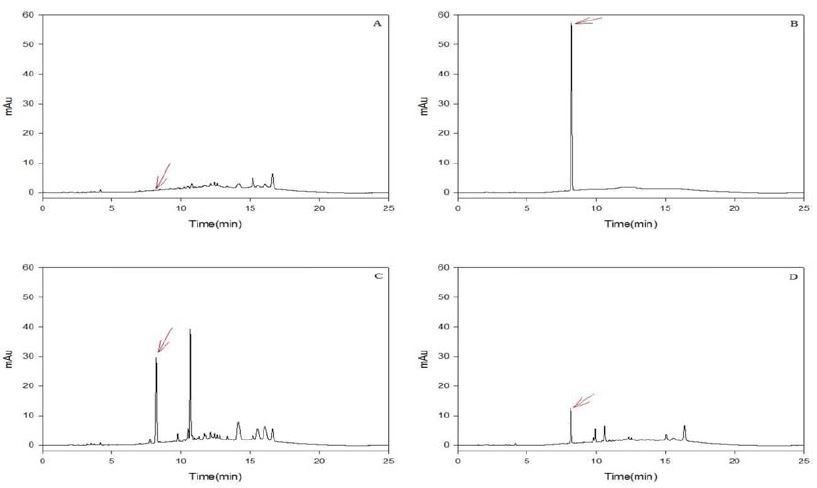
Chromatograms of boscalid in jujube using HPLC-DAD (A: control, B: standard solution 10 mg L−1, C: recovery fortification level 1.0 mg kg−1, D: sample).
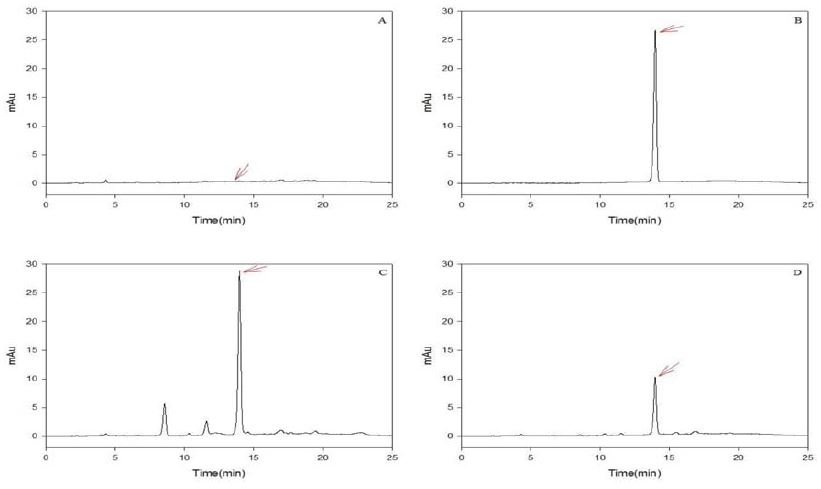
Chromatograms of pyraclostrobin in jujube using HPLC-DAD (A: control, B: standard solution 10 mg L−1, C: recovery fortification level 2.0 mg kg−1, D: sample).
대추 중 시험농약의 잔류량 변화
대추에 대한 안전사용기준에 따라 표준희석살포농도로 살포한 boscalid와 pyraclostrobin의 초기(살포 2시간 후 채취한 시료) 잔류량을 분석한 결과, boscalid는 포장 1에서 0.40 mg kg−1, 포장 2에서 0.48mg kg−1이었고, pyraclostrobin은 포장 1에서 0.76 mg kg−1, 포장 2에서 0.57 mg kg−1으로 확인되었다. 시험물질 모두 초기잔류량부터 MRL보다 2배 이상 낮게 검출되었으며 0일차부터 14일차까지 잔류량은 Table 6과 같다. 약제별로 살포방법, 유효함량, 살포입자, 기상환경, 작물의 형태 등에 의해 잔류량이 다르게 나타날 수 있으며(Ricco et al. 2006, Wang and Liu 2007), 대추에서 boscalid와 pyraclostrobin의 14일 간 잔류소실율을 보면 boscalid의 경우 포장 1에서 54.5%, 포장 2에서 57.2%이었고 pyraclostrobin의 경우 포장 1에서 80.3%, 포장 2에서 52.9%이었다. Boscalid의 경우 잔류소실율이 큰 차이가 없었으나, pyraclostrobin의 경우 잔류소실율이 30% 가까이 차이가 났다. 이 결과로 볼 때, boscalid는 강우에 따른 소실율은 크지 않은 것으로 판단되나 pyraclostrobin는 강우에 따른 소실율이 큰 것으로 판단된다. Boscalid 및 pyraclostrobin을 함유한 품목 및 제형의 경우, 내우성이 우수하다고 알려져 있어 제형의 차이는 없는 것으로 판단된다. 일반적으로 엽채류 및 과채류의 경우, 농약잔류에 영향을 미치는 요인 중 하나로 작물의 비대생장에 의한 농약의 희석효과를 들 수 있는데(Marin et al., 2003), 대추의 경우는 비대생장이 아닌 작물로 생장에 의한 잔류소실은 미비한 것으로 판단된다. Hur et al. (2005) 등은 잔류량과 시간과의 관계를 가장 유의성 있게 보여주는 kinetic model에 따라 산정해야 함은 당연하다고 하였으나, Han et al. (1955) 등은 농약의 잔류유형을 나타내는 최적 model이 농약의 종류 및 환경조건에 따라 다를 수 있고 이에 따라 t1/2의 변화폭이 크기 때문에 first order kinetic model을 일률적으로 적용하는 것보다 최적 model을 선정하고 이로부터 t1/2를 산출하는 것이 바람직하다고 하였다. Boscalid와 pyraclostrobin의 평균잔류량을 근거로 생물한적반감기를 산출하였을 때, boscalid의 경우 포장 1에서 11.0 일, 포장 2에서 13.2 일이었으며, pyraclostrobin의 경우 포장 1에서 6.1 일, 포장 2에서 12.7일었다. 이와 관련하여 다른 문헌에서는 boscalid의 반감기를 오이에서 1.9일, 딸기에서 2.9, 3.1일로 보고한 바 있으며(Lee et al., 2008, Jankowska et al., 2016), pyraclostrobin의 반감기를 딸기에서 2.7, 2.8일로 보고한 바 있다(Jankowska et al. 2016). 본 연구에서 산출된 대추 중 boscalid와 pyraclostrobin의 반감기가 다른 문헌들에서 조사된 반감기보다 2배 이상 차이나는 걸로 확인되었는데, 이는 증체에 따른 희석효과의 차이로 사료된다. 이러한 반감기 차이가 시험 작물이 재배되는 지역의 기상환경 차이로 기인한 것이라는 연구결과(Hwang and Kim 2014)들이 있고 대추 중의 반감기 차이 또한 각 약제의 특성 및 지역의 기상환경 등에 의한 차이로 사료된다.
Acknowledgments
본 연구는 2015 생산단계 잔류허용기준 설정을 위한 시험연구 결과의 일부이며, 식품의약품안전처의 연구개발비 지원에 감사드립니다.
References
-
Han, B. H., M. H. Park, (1987), Sedative activity and its active components of Zizyphi fructus, Arch Pharm Res, 10, p208-211.
[https://doi.org/10.1007/bf02857741]

- Han, D. S., J. E. Yang, and D. S. Park, (1995), Comparative assessment of the half-lives of benfuresate and oxolinic acid estimated from kinetic models under field soil conditions, Korean J. Environ. Agric, 14(3), p302-311.
- Hur, J. H., D. S. Park, K. Y. Seong, and K. Choi, (2005), Field tolerance of pesticide in the strawberry and comparison of biological half-lives estimated from kinetic model, Korean J. Pestic. Sci, 9(3), p231-236.
- Hwang, J. I., and J. E. Kim, (2014), Residual patterns of acaricides, etoxazole and flufenoxuron in apples, Korean J, Pestic. Sci, 18(2), p61-68.
-
Jankowska, M., K. Piotri, H. Izabela, and L. Bozena, (2016), Dissipation of six fungicides in greenhouse-grown tomatoes with processing and health risk, Environ. Sci. Pollut. Res, 23, p11885-11900.
[https://doi.org/10.1007/s11356-016-6260-x]

- KCPA, (2016), Using guideline of crop protection agents, Korea Crop Protection Association, Samjung Inc, Seoul, Korea, p66-67, 120.
- Lee, J. H., H. W. Park, Y. S. Keum, C. H. Kwon, Y. D. Lee, and J. H. Kim, (2008), Dissipation pattern of boscalid in cucumber under greenhouse condition, Korean J, Pestic. Sci, 12(1), p67-73.
- Lee, Y. G., S. Y. Cho, (1995), Effect of jujube methanol extract on benzo(a)pyrene induced hepatotoxicity, Korean J. Soc. Food Nut, 24, p127-132.
- Marin, A., J. Oliva, C. Garcia, S. Navarro, and A. Barba, (2003), Dissipation rates of cyprodinil and fludioxonil in lettuce and table grape in the field and under cold storage conditions, J. Agric. Food Chem, 51(16), p4708-4711.
- Ministry of Food and Drug Safety, (2013), Korean Food Standards Codex Pesticide Analytical Manual 4th ed., Ministry of Food and Drug Safey, Korea, p4.
- Na, H.S., K. S. Kim, and M. Y. Lee, (1996), Effect of jujube methanol extract on the hepatotoxicity in CCl4-treated rats, Krean J. Soc. Food Sci. Nutr, 25, p839-845.
- Park, J. H., J. S. Park, A. M. Abd El-Aty, M. Rahman, T. W. Na, and J. H. Shim, (2012), Analysis of imidacloprid and pyrimethanil in shallot (Allium ascalonicum) grown under greenhouse conditions using tandem mass sepctrometry: establishment of preharvest residue limits, Biomed, Chromatogr, 27(4), p451-457.
- Rhee, Y. K., D. H. Kim, and M. J. Han, (1998), Inhibitory effect of Zizyphi fructus on β-glucuronidase and tryptophanase of human intestinal bacteria, Korea J. Food Sci. Technol, 30, p199-205.
- Ricco, R., M. Trevisan, and E. Capri, (2006), Effect of surface waxes on the persistence of chlorpyrifos-methyl in Apples, Strawberries and grape fruits, Food Addit. Contam, 23(7), p683-692.
- Turner, J. A., (2015), In A world compendium The Pesticide Manual, 16th ED, J. A. Turner Eds, British Crop Production Council, Alton, Hampshire, UK, 125-126, 951-952.
-
Yagi, A., A. Koda, and I. Nishioka, (1981), Studies on the constituents of Zizyphi fructus. IV. Isolation of an antiallergic component, ethyl-a-D-fructofuranoside from EtOH extract of Zizyphi fructus, Yakugaku Zasshi, 101, p700-707.
[https://doi.org/10.1248/yakushi1947.101.8_700]

- Yu, T. J., (1999), Food Dongeuibogam, Acadimi book, Seoul, p138-140.
-
Wang, C. J., and Z. Q. Liu, (2007), Foliar uptake of pesticides-present status and future challenge, Pestic. Biochem. and Phys, 87, p1-8.
[https://doi.org/10.1016/j.pestbp.2006.04.004]


